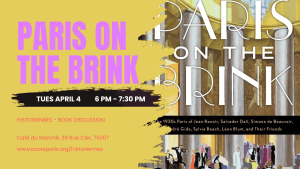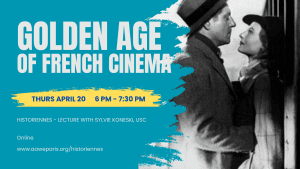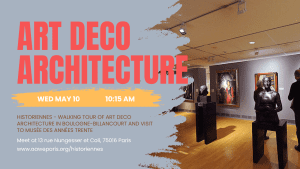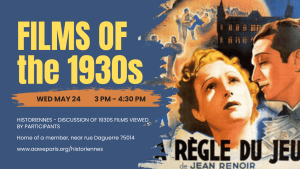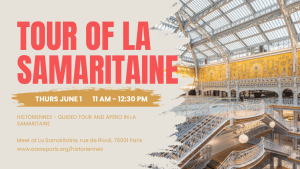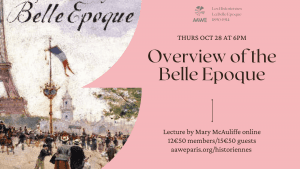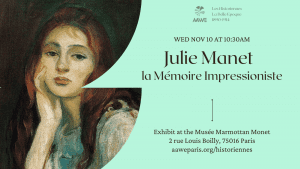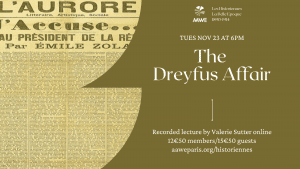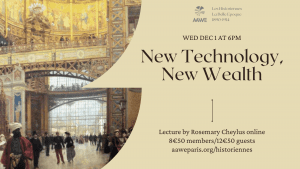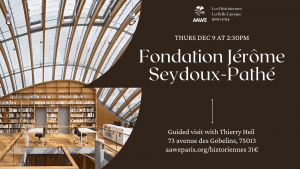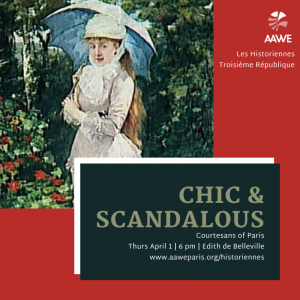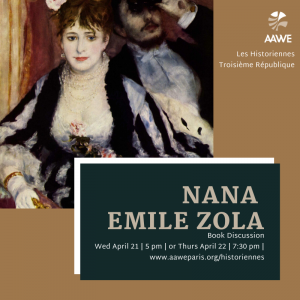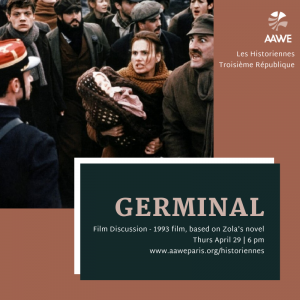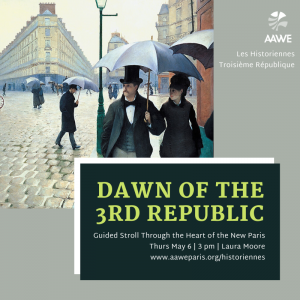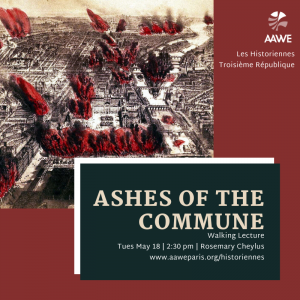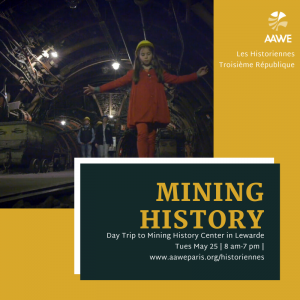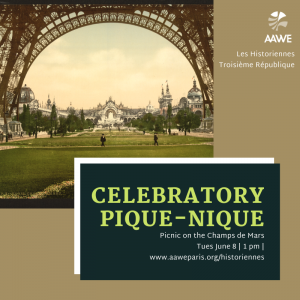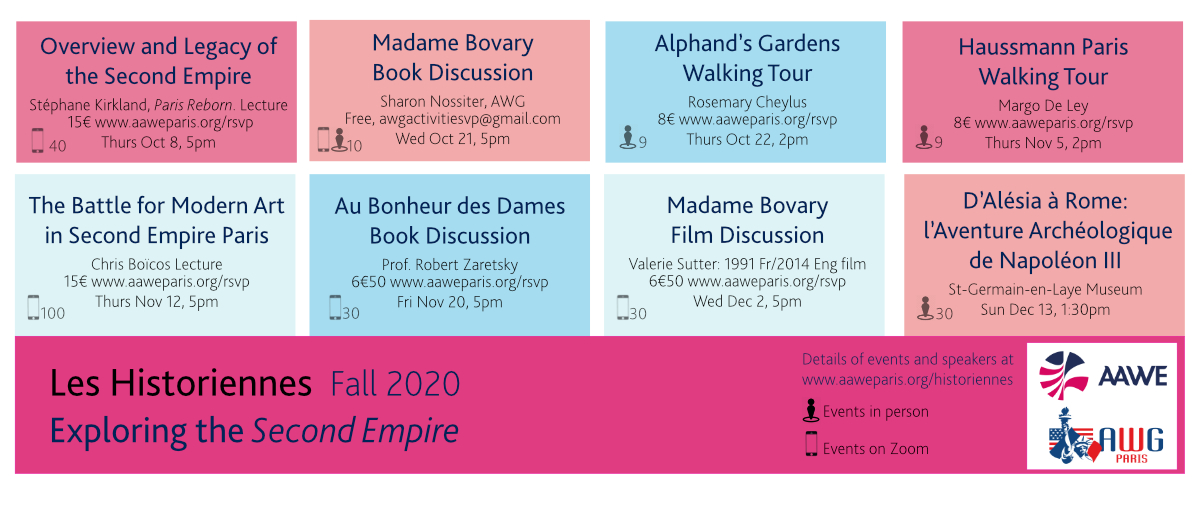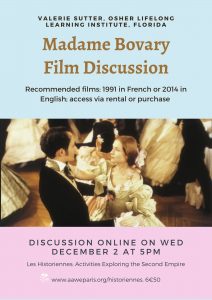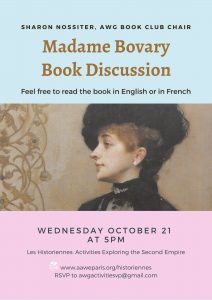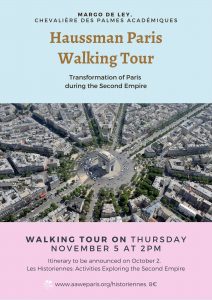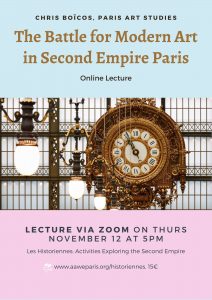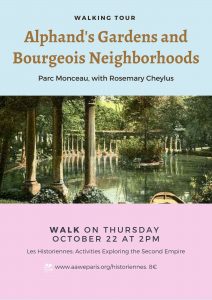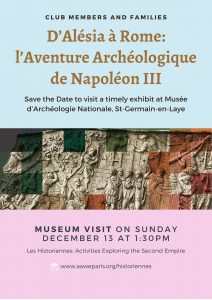Les Historiennes Fall 2023: Immigration in France
Join Les Historiennes, a project involving women in AAWE and AWG, for our series on Immigration, with events focusing on history and culture. This fall’s series kicks off with a lecture/conversation with Professor Catherine Wihtol de Wenden, noted immigration scholar, who will discuss her latest book on how France has viewed the immigrant from 1870 to 2022. Check the AAWE calendar at https://aawe.wildapricot.org/events for events and how to register for them.
Immigration from East and South-East Asia
Thursday February 15, at 11am
RSVP (10.50€) at https://aawe.wildapricot.org/event-5586747
Location: Musee de l’Histoire de l’Immigration, Palais de la Porte Doree, 293 av Daumesnil, 75012
Join us to visit this exhibition at Palais de la Porte Dorée. Please register quickly (latest Feb 4), so we reserve our tickets.
Les Historiennes group visit of the exciting and informative exhibit on East and Southeast Asian Immigration to France since 1860. This exhibit vividly documents the experience of immigrants from the region, including China, Vietnam, Laos, Cambodia, Japan, Korea, Thailand and the Philippines over the past 160 years. Immigrants from these countries make up 6% of the current foreign-born population. The exhibit illustrates the changing political and economic factors which have driven these demographic trends during the colonial and post-colonial eras, and the wide range of experiences of different immigrant groups.
France, particularly Paris, offered a space of political freedom to Asian students, intellectuals and artists. In parallel, during the two World Wars a range of industrial and agricultural workers were recruited to support the French economy, many of whom settled in provincial areas after the end of hostilities. The exhibit displays a varied range of historical and cultural material, including documents, posters, personal diaries and photos, which helps to bring their stories to life. AAWE is planning to purchase tickets for up to 12 participants to attend the exhibit on Thursday, February 15 at 11am. RSVP by February 6 to ensure you get to see this much sort-after event before it closes.
Migration: The Long, Hard Road from Portugal to France
Tuesday January 30, 2024, at 6pm, online
RSVP at https://aawe.wildapricot.org/event-5449169
From Radio France International (RFI)—an article, podcast, and video in English (or subtitled) that vividly tell the story of Portuguese immigrants in France, presented by Les Historiennes
Via Zoom
The Portuguese in France make up one of the country’s longest-established communities. Arriving mainly in the 1960s and 70s, they faced tough working conditions, life in shantytowns, and resentment from some of the local population. Their story, for many years thought best forgotten, is vividly described by those who lived those early years interviewed by RFI. Their journey and settling in France are celebrated in a monument in a town to the east of Paris.
A cluster of six towns along the banks of the River Marne are still home to many of France’s some 83,000 people of Portuguese origin, according to the country’s embassy in Paris (2018).
“We came because, first of all, we had nothing in Portugal,” remembers Valdemar Francisco, who came to France as a child in the 60s.
His family came from Leiria, a region in central Portugal where France opened an immigration bureau. “French doctors went to Portugal to choose people to come to France and the doctors examined people’s teeth, saw if people were strong … They would send the person’s name to France and French companies would send a contract.”
Join Les Historiennes for this collection of stories and images captured by RFI journalists in their visit to Champigny-sur-Marne in 2018.
.
US and European Policy on Migrant Youth: International and Historical Contexts and Case Studies
A Conversation with Professor Jody McBrien
Rescheduled to Tuesday Dec 5, at 6pm, online and 75014
RSVP at https://aawe.wildapricot.org/event-5432631
This talk will examine policies and case studies regarding child refugees and asylum seekers in the European Union and the United States, as well as other migrant youth. It will include background on international documents designed to protect children, and challenges children face in education and integration. These documents include the UN Convention on the Rights of the Child, from 1990; the Optional Protocol on the Involvement of Children in Armed Conflict, adopted in 2000; and the European Union Strategy on the Rights of the Child, from 2021.
Jody McBrien is a Professor in the School of Interdisciplinary Global Studies at the University of South Florida. Her primary research has been with refugee youth, and she is the author of roughly 50 scholarly articles, chapters, and books.
Via Zoom and In-Person (Hybrid Event) at the home of an AAWE Member near Rue Daguerre in Paris 14e (specific address will be provided to registrants). In-Person participants should plan to arrive by 5:45 p.m. to ensure a prompt start of the event.
.
Catherine Wihtol de Wenden discusses Perceptions of Migrants in France
Tuesday Oct 10, at 3pm at the MVAC du 16e, 75016 Paris
RSVP at https://aawe.wildapricot.org/event-5414766
Lecture/Conversation in English by immigration scholar Catherine Wihtol de Wenden, on her book, Figures de l’Autre: Perceptions du Migrant en France 1870-2022.
Mme de Wenden is Director of Research Emerita at the Institut de Sciences Politiques and the Centre National de Research Scientifique (CNRS).
We will meet at the Maison de la Vie Associative et Citoyenne du 16e, at 14 av René Boylesve, 75016 Paris. https://goo.gl/maps/hSXpNNXWzpnT7b8b8
(Metro: Passy. Bus 72. RER C: Avenue du Président Kennedy Maison de Radio France. Vélib: rue Chernoviz.)
Guided visit to Musée National de l’Histoire de l’Immigration
Thursday Oct 12, at 2:15pm at Musee National de l’Histoire de l’Immigration, Palais de la Porte Dorée, 293 avenue Daumesnil, 75012 Paris
RSVP at https://aawe.wildapricot.org/event-5414768
Plan to arrive at 2:15pm for this 2:30pm guided visit in English at the Musée de l’Histoire de l’Immigration, a magnificent art deco building recently renovated and expanded, for an eye opening visit about the History of French immigration.
The history of immigration to France is a fascinating tapestry of human mobility and cultural integration from ancient and medieval times to the aftermath of the colonial era when the French empire spanned Africa, Asia and the Americas. The end of World War II also prompted a rise in immigration mainly from Italy, Spain, Greece and Portugal. All these factors and many others have transformed France into the culturally diverse nation with many distinct ethnic communities which it is today. In addition, the museum shows how political migrants and asylum seekers from countries such as Vietnam, Cambodia and Laos, Afghanistan and Syria, and Eastern Europe, later sought refuge in France, playing a significant role in shaping French immigration.
Concert of Duved and His Transatlantic Five, “Django Reinhardt: The Golden Age of Jazz”
Saturday Oct 14, at 8pm at Le Bal Blomet, 31 Rue Blomet, 75015 Paris
RSVP at https://aawe.wildapricot.org/event-5414769
Enjoy the music of Belgian Django Reinhardt, blending American and tzigane musical traditions, played for us in Paris by an international group of renowned musicians.
Register at https://aawe.wildapricot.org/event-5414769 to RSVP to AAWE. You must also RESERVE directly (22 euros) on the website of Bal Blomet (www.balblomet.fr/evenement/duved-octobre-2023/edate/2023-10-14/) Reserve soon, since most Bal Blomet concerts sell out. Doors open at 7pm and there is open seating.
Past Les Historiennes Events
Les Historiennes’ Spring 2023 series: Paris in the 1930s
Paris in the 1930s had investment scams, exploitation of France’s colonies, a period of contrasts between rich and poor, cultural figures such as Jean Renoir, Salvador Dali, Simone de Beauvoir, André Gide, Sylvia Beach, rich art and architecture, a golden age for French cinema. We discovered it in Spring 2023 with Les Historiennes!
Stavisky, film viewing and discussion
Tuesday March 28, at 3pm at the home of a member, Ile de la Cité 75004 Paris
Discussion led by Jill Bourdais
Taking place essentially between July 1933 and April 1934, this film by Alain Resnais traces the final months of the “Bernie Madoff of France” of the period. Serge Alexander Stavisky, played by Jean-Paul Belmondo, was a financier and embezzler at the highest levels of society and politics. His actions created a political scandal that became known as the Stavisky Affair. In the aftermath of Stavisky’s death there was rioting in the streets of Paris, resulting in 250 arrests as news of government involvement in the financial scandal broke.
Join us in viewing this highly regarded film, followed by a discussion of finance and politics in France during the 1930s.
Paris on the Brink: Book Discussion
Tuesday April 4, at 6pm at Café du Marché, 38 Rue Cler, 75007 Paris
In Person Book Discussion: Mary McAuliffe’s Paris on the Brink: The 1930s Paris of Jean Renoir, Salvador Dalí, Simone de Beauvoir, André Gide, Sylvia Beach, Léon Blum, and Their Friends. Discussion led by Rosemary Cheylus
Paris on the Brink vividly portrays the City of Light during the tumultuous 1930s, from the Wall Street Crash of 1929 to war and German Occupation.
This was a dangerous and turbulent decade, during which workers flexed their economic muscle and their opponents struck back with increasing violence. As the divide between haves and have-nots widened, so did the political split between left and right, with animosities exploding into brutal clashes, intensified by the paramilitary leagues of the extreme right. Hitler, Stalin, and Mussolini escalated the increasingly hazardous international environment, while the civil war in Spain added to the instability of the times.
Yet throughout the decade, Paris remained at the center of cultural creativity. Major figures on the Paris scene, such as Gertrude Stein, Ernest Hemingway, André Gide, Marie Curie, Pablo Picasso, Igor Stravinsky, and Coco Chanel, continued to hold sway, in addition to Josephine Baker, Sylvia Beach, James Joyce, Man Ray, and Le Corbusier. Simone de Beauvoir and Jean-Paul Sartre could now be seen at their favorite cafés, while Jean Renoir, Salvador Dalí, and Elsa Schiaparelli came to prominence, along with France’s first Socialist prime minister, Léon Blum.
The Golden Age of French Cinema 1930-1939
Thurs April 20, at 6pm
Zoom Lecture with Sylvie Koneski, University of Southern California, Paris
Throughout the turbulent decade, French cinema provided a welcome escape from the consequences of the world-wide Depression and the political tensions of the day. It also mirrored the changing political climate in France: The misplaced optimism in the Front Populaire and the darkening mood, as Fascism took root in Europe.
French filmmakers created masterpieces during this period, like Jean Renoir’s Great Illusion and The Rules of the Game, the last now considered one of the all-time greats of French cinema. Marcel Carné’s Port of Shadows and Daybreak and Jean Vigo’s Atalante belong to another artistic current, labelled Poetic Realism. Jean Renoir’s La Bête humaine and Julien Duvivier’s Pépé le Moko prefigure American film noir. The 1930s also marked the beginning of the star system. The most famous are Michel Simon, Jean Gabin, Jules Berry, Arletty, and Michèle Morgan.
Join us for this overview of French 1930s film, which will include extracts from the major films of the period.
Walking Tour of Art Deco Architecture in Boulogne-Billancourt and Visit to Musée des Années Trente
Wed May 10, at 10:15am
Guide: Thierry Heil of Interkultur
The event will start with a guided walking tour of Boulogne-Billancourt’s 1930s buildings. We will stroll through the “Parcours des Années 30” stretching from centre to the north edge of the city, amid public and residential buildings and artist studios built by Le Corbusier, Courrèges, Mallet-Stevens ou Terry. The tour will end at the Musée des Années Trente in Boulogne-Billancourt, which we will visit without a guide.
This municipal museum is a hidden gem, especially for lovers of Art Deco. Created to celebrate both the arts and industry during a period in which noted performers, architects, painters, sculptors, and film makers were attracted to the town, it houses collections of paintings, sculptures, drawings, furniture, ceramics, another objects. It includes “orientalist” works, from France’s overseas colonies at the time.
Discussion of 1930s Films Viewed by Participants
Wednesday May 24, at 3pm, at the home of a member, near rue Daguerre, 75014 Paris
As part of Sylvie Koneski’s lecture on April 20, we narrowed our selection to four major films, thus allowing us to delve in depth into such questions as how women are portrayed; political, social, and romantic themes; structure; actors, and other aspects of the chosen films.
Guided tour and apéro in La Samaritaine
Thursday June 1, at 11am at La Samaritaine, rue de Rivoli, 75001 Paris
The company was initially owned by Ernest Cognacq and Marie-Louise Jaÿ who hired architect Frantz Jourdain to expand their original store. It started as a small apparel shop and expanded to what became a series of department store buildings with a total of 90 different departments. It was completed in 1928—nine stores within four buildings–designed to entice working class shoppers to climb the stairs of a multi-story building by using grand and decorative elements.
The building has been listed since 1990 as a monument historique by the French Ministry of Culture and is a stunning example of the evolution of architecture in the first two decades of the twentieth century. Its magnificent restoration allows us to imagine the experience of a shopper in the 1930s. It was clearly the place to shop in Paris at the time!
Concluding Lunch at La Coupole
Thursday June 8, at 1pm, at 102 Bd du Montparnasse, 75014 Paris
La Coupole was founded in 1927 when Montparnasse housed a large artistic and literary community – expatriates and members of the Lost Generation. They decorated the place in the contemporary art deco style and were regular patrons. It quickly became a huge success—a place to be seen for the Tout Paris of Paris between the wars. The downstairs “Dancing de la Coupole” opened in late 1928 and became a haven for dancers of the rumba, bolero, guaracha, samba and other dances into the 1960s. Among its early patrons were Jean Cocteau, Foujita, Kisling, Giacometti, Zadkine, Josephine Baker, Man Ray, Georges Braque, Louis Aragon, and Elsa Triolet. Its fans during the 1930s included Picasso, Simone de Beauvoir, Jean-Paul Sartre, Sonia Delaunay, André Malraux, Jacques Prévert, Marc Chagall, and Edith Piaf. And during the 2020s… Les Historiennes!
Les Historiennes’ Spring 2022 series: Les Années Folles in Paris 1918-29
Les Historiennes series romped through this period of radical change and rich social, artistic, and cultural collaborations. War-weary France was ready to embrace new movements that emerged both within France and from influences and emigrés from abroad. It was when Art Deco replaced Art Nouveau and café society flourished in Montparnasse, settled by American expatriates and international artists such as Soutine, Modigliani, and Chagal. Surrealism emerged in literature, art, and film.
Entertainment was transformed as nightlife was influenced by American culture, especially Josephine Baker and the Harlem Hellfighters of the 369th Infantry Regiment—the instigators of “ragtimitis in France!” Radio became the preferred vehicle for the new mass culture. The body gained a new freedom, as seen in the renewal of ballet, the popularity of sports spectacles, the garçonne (flapper) look in fashion, and the little black dress – precisely in 1926. There was a boom in industry once the nation had reconstructed from WWI. It all came to an end after the Wall Street Crash of 1929, which reached Europe two years later.
We explored this exciting era through three Zoom lectures–an overview by author Mary McAuliffe, a presentation by Fiona Casey on abortion and other women’s issues, and a discussion of books by Ernest Hemingway and Janet Flanner. We were guided through the Musée d’Art Moderne by Chris Boicos, attended a jazz concert at the Bal Blomet, visited the new expo of ’20s artists at the Musée du Luxembourg, hung out at the piano bar of the Closerie des Lilas, and enjoyed a tour of places featured in the film Midnight in Paris.
.
Overview of Roaring ’20s Paris
Wednesday March 23 at 6pm, online lecture, with Mary McAuliffe
Author Mary McAuliffe is back by popular demand, to lecture on the topic of her book, When Paris Sizzled: The 1920s Paris of Hemingway, Chanel, Cocteau, Cole Porter, Josephine Baker, and Their Friends. Mary will touch upon the key individuals, movements, transformations, and undercurrents of the period. Yes, she will speak about the seismic changes on almost every front, and major figures that we know well and would like to know more intimately—those mentioned in her title along with Picasso, Stravinsky, Proust, May Ray, Diaghilev, and many others. But she will also reveal an undercurrent of despair and the rise of a ruthless extreme right. Mary will describe the rich cultural life of Montparnasse, its bars, and its cafes, preparing Les Historiennes participants for other spring events in which we will visit those very places ourselves!
Guided Visit of the Musée d’Art Moderne with Chris Boicos
Tuesday March 29 at 11:00 a.m. at 11 Avenue du Président Wilson, 75116 Paris. Maximum: 15 participants
Art Historian Chris Boicos (Paris Art Studies) will lead us through the collection of this Paris museum. The works we’ll see will include works by Picasso, Dufy, De Chirico, Foujita, Buffet, Matisse, Bonnard, Laurencin, the Delaunays, Chagal, Braque, Modignliani, Valadon, Zadkine, and many more. The collection includes drawings, paintings, decorative arts, photographs, and sculptures. Chris will discuss the various movements of the period and the artistic and social contexts in which they were created.
Jazz Concert at the Bal Blomet
Thursday April 14 at 33 rue Blomet, 75015 Paris. Arrive: 7pm for the Concert at 8pm
Le Bal Blomet (www.balblomet.fr) was created in 1924 and was quickly called Le Bal Negre. It was an amazing spot that, fortunately for us, was restored and reopened in 2017. A musician who played there in the 20s said, “This period probably was the craziest that I have lived. That ball was the hot spot of the capital… And not a single foreigner would leave Paris without having spent at least one night in this unusual place.” Tourists did indeed show up by the busloads. “The address had become so famous in Paris that we only had to tell a taxi driver ’33…’ for him to add ‘…rue Blomet.’ “ Artists of the Roaring Twenties attended the Bal Blomet religiously, including Joséphine Baker, Maurice Chevalier, Mistinguett, Foujita, Kiki de Montparnasse accompanied by Man Ray or Alexander Calder. Henry Miller, Ernest Hemingway, Francis Scott Fitzgerald would gather there, as would painters Joan Miro, Francis Picabia, Jules Pascin, Moise Kisling and Kees Van Dongen accompanied Robert Desnos and their surrealist friends. Join us for an evening of jazz, featuring clarinette favorites.
The Criminal Misdemeanor: The Story of Abortion in Interwar France
Tuesday April 26 at 6pm, online lecture by Fiona Casey
We are delighted that Fiona Casey, Doctor in Contemporary History at the Ecole Supérieure d’Agricultures in Angers, will be sharing the topic of her doctoral thesis with us. It touches on many themes related to women during our chosen period. These themes include the impact of World War I on French women, the history of sexuality, French feminism, the roots of Vichy, and more!
Hemingway’s A Moveable Feast and/or Flanner’s Paris Was Yesterday: 1925 – 1939
Wednesday May 11 at 6pm, online book discussion
Many of us may have read Hemingway’s iconic book and may want to re-read it or… read Janet Flanner’s account of life in the Paris over some of the same period. Here’s what Shakespeare and Company say about Flanner’s book: In 1925 Janet Flanner began writing a fortnightly ‘Letter from Paris’ for the nascent New Yorker….to tell New Yorkers, under her pen name of ‘Genet’, what the French thought was going on in France, not what she thought. Paris Was Yesterday …. reads like an Arts Who’s Who. Flanner saw it all and knew everyone (or at least all about them), and there are tidbits galore about the likes of James Joyce, Ernest Hemingway, Isadora Duncan, Diaghilev, Gertrude Stein, Scott and Zelda Fitzgerald, Picasso, Marlene Dietrich…It’s witty, catty, literary and unashamedly gossipy, a lively portrait of the thriving cultural life in Paris between the wars. In the brilliantly entertaining style she made her own, Flanner mixed high and low culture to devastating effect.”
Exhibit visit to Pionnières: Artistes dans le Paris des Années Folles
Friday, May 20 at 11am
Through painting, sculpture, photography, film, textiles, and literary works, this exhibit highlights the primordial role of women in the development of the great modern movements. These “femmes nouvelles” are the first to gain recognition as artists, to have a studio, a gallery or a literary editor, and to become teachers of art. They dressed as they wished and lived their sexuality as they chose. The interdisciplinary nature of their creative works influenced many during their time and continues have an influence today. The Museum’s brief description of the historical context of “les Années Folles,” https://museeduluxembourg.fr/fr/actualite/le-paris-des-annees-folles provides a succinct background both for the show and for our spring series of events.
Cocktails at the Piano Bar of the Closerie des Lilas
Wednesday, May 25 at 6pm at 171 Boulevard du Montparnasse, 75006 Paris.
Join AAWE and AWG members in the Closerie’s cozy Bar Hemingway, a favorite spot of many illustrious writers and artists of the 19th and 20th centuries, from Verlaine to Hemingway, from Picasso to Gide. Enjoy the chic sounds of the piano, friendly conversation, and the Closerie’s creative and classic cocktails.
Walking Tour of Sites of the Film Midnight in Paris
Tuesday, May 31 at 10am
Go back in time and stroll through Paris in the 1920s! Take the stairs featured in the film Midnight in Paris and walk through the Latin Quarter. We will be walking by spots made famous during the Années Folles.” See where the artists of the period flocked together for creative sessions, why Paris became a mecca for culture during this time period, and the ideals that came from it. We will end our tour at 12:30 pm at the historic restaurant Polidor—another Hemingway haunt—for a lunch to recap our spring Historiennes series. The Polidor https://www.polidor.com/en/home is located at 41 Rue Monsieur le Prince, Paris 6e.
Les Historiennes’ Fall 2021 series: La Belle Epoque 1890-1914
The fall series of events created by Les Historiennes focused on La Belle Epoque, from 1890 to 1914. It was an era characterized by flamboyance, invention, discovery, scandal, and social divisions, that is so rich in its diversity that we will devote both fall and spring to it!
There was nostalgia for the glitter of past eras and at the same time a bursting forth of “modern” forms of art, new social movements, and scientific and technological innovations. While new industries benefited a newly wealthy elite, they also broadened access to culture and leisure to ordinary people.
Our “overview” lecture on the period was provided by Mary McAuliffe, author of Dawn of the Belle Epoque and Twilight of the Belle Epoque. The series offeed a mix of types of events, including online lectures (to include AAWE and AWG members outside of Paris), a concert and apéro, a museum exhibit, a guided visit of a cinémathèque, and a lunch at an Art Nouveau restaurant.
Art Nouveau Architecture
Thursday, October 14 at 6:00pm, online lecture, with Thierry Heil
The fall series kicks off with a lecture by Thierry Heil, professional guide and founder of Interkultur.
Thierry will deepen our understanding of Art Nouveau architecture, a decorative movement that flourished in Paris from 1870 to its culminating moment at the turn of the century. We see examples of it up until the start of World War I.
From the Paris Metro stations to flamboyant facades to interior design and décor, Art Nouveau is hard to escape in Paris! Clearly the Art Nouveau movement, while not originating in France, represented an exuberant departure from existing art traditions. Not appreciated by all, it was called “style nouille” (noodle style) by its critics! Join Thierry for a virtual stroll by and into the amazing examples of Art Nouveau architecture in the city.
Le Sacre du Printemps by Igor Stravinsky
Friday, October 22 at 6:30pm for Apéro and 8pm for Concert
Concert at Maison de la Radio et de la Musique, 116 av du Président Kennedy, 75016
Stravinsky’s Rite of Spring was composed between 1910 and 1913 as a ballet originally choreographed by Vaslav Nijinski for the Ballets Russes of Serge de Diaghilev.
It was first performed at the Theatre des Champs-Elysees in 1913, and caused an uproar among the audience, with bourgeois traditionalists and bohemians attacking one another.
This concert includes the piece, along with Stravinsky’s Septuor and Shostakovich’s Concerto for Violin and Orchestra no. 1. They will be performed by the Philharmonic Orchestra of Radio France.
Jill Bourdais of AAWE will provide us with an introduction to the Rite of Spring at 18h30 at a nearby café. Purchase your own concert ticket via the Maison de la Radio website.
Overview of the Belle Epoque
Thursday, October 28 at 6:00pm, online lecture, with Mary McAuliffe
Mary McAuliffe is the author of numerous books on Paris including Dawn of the Belle Epoque: the Paris of Monet, Zola, Bernhardt, Eiffel, Debussy, Clemenceau, and Their Friends, and of Twilight of the Belle Epoque: the Paris of Picasso, Stravinsky, Proust, Renault, Marie Curie, Gertrude Stein, and Their Friends Through the Great War. The first book covers the period 1870 – 1900; the second one, 1900 – 1918. Obviously, she can’t cover in an hour-long Zoom all the details she presents in two volumes, but she can provide us with highlights of this vibrant period, which saw a struggle between the forces of tradition and those of modernity, republicans clash with monarchists, the Republic with the Church, economic malaise, rising anti-Semitism, Paris in full bloom as the century turned, “modern” movements in art and literature, and discoveries that changed every arena of life. Join us for an opportunity to hear from a noted author on our chosen period!
Julie Manet: la Mémoire Impressioniste
Wednesday, November 10th at 10:30am. Exhibit at the Musée Marmottan Monet, 2 Rue Louis Boilly, Paris 16th
Julie Manet was the only child of Berthe Morisot and niece of Edouard Manet. As a teenager, she wrote a journal, chronicling events and people in the art world and more broadly over the period 1893 – 1899, including the Dreyfus Affair.
This exhibit sheds light on her role in the world of art; on her work and that of her husband, the painter Ernest Rouart, as art collectors; and on the work of her mother, Berthe Morisot. Julie served as a model in many paintings of her mother and of other impressionist painters.
Come and enjoy a unique perspective on life and art during the Belle Epoque provided by a young woman growing up at that time. Purchase your own ticket for the 10:30 am slot or just before or after, in order to enjoy the exhibit with your fellow AAWE and AWG members. We will announce to those registered a café in which to meet afterwards for a bite and to exchange our impressions of the exhibit.
The Dreyfus Affair
Tuesday, November 23rd at 6:00pm. Recorded online lecture by Valerie Sutter
AWG member Valerie Sutter lectures and teaches French history and culture in Florida and Paris. She gave a superb lecture on the Dreyfus Affair earlier this year to the Friday Tour Group, which recorded it. Both she and Friday Tour Group have agreed to make the lecture available to the Historiennes of AAWE and AWG!
Valerie brings alive this complicated and tragic affair which tore France apart for more than two decades, thanks to her knowledge and passion for the topic and her ability to tell a complex story in an engaging way. Join us to view Valerie’s lecture and to discuss it ourselves afterwards. Those in France may want to view the film J’Accuse, which came out in 2019.
New Technology, New Wealth
Wednesday, December 1st at 6:00pm. Online lecture by Rosemary Cheylus
The Belle Epoque saw a second industrial revolution in France in which new technological discoveries brought immense wealth to families in a position to take advantage of them. Join us for a lecture by AAWE member Rosemary Cheylus, who has been researching the emergence of this new financial elite and the inventions that brought them unprecedented wealth and positioned them in fact to replace France’s aristocracy.
Fondation Jérôme Seydoux-Pathé
Thursday, December 9th at 2:30pm. Guided visit by Thierry Heil at 73 avenue des Gobelins, 75013
It was during the Belle Epoque that cinema was created, through the efforts of the Lumière Brothers, the Pathé brothers, George Méliès, and others.
Charles and Emile Pathé built the first international film empire, making and distributing films in the early days of cinema. The Fondation is an important center for the preservation and study of the development of the film industry.
Thierry will provide a private tour of the Fondation and speak about the contributions of the Pathé brothers, the early development of cinema, and the context of the period—one in which technology revolutionized popular culture and entertainment. Participants may wish to visit the exhibit on the early discoveries leading to the creation of movies, “Enfin le cinéma!” at Musée d’Orsay and the new Musée Méliès at the Cinémathèque prior to the visit to the Fondation!
Brasserie Vagenende
Monday, December 13th at 1:00pm. Lunch in a beautifully-preserved Art Nouveau décor at 142 boulevard Saint Germain, 75006
Would you like to exchange impressions of the events of the series with other Historiennes? Would you like to immerse yourself in a Belle Epoque environment?
We culminate the fall event series by returning to Art Nouveau, in the beautifully preserved décor of the Brasserie Vagenende in Saint-Germain-des-Près. It was founded in 1904 as one of the Chartier restaurants, a chain of brasseries founded by brothers Edouard and Camille Chartier—creators of the Bouillon Chartier.
Be sure to register for the event, so we will know how many participants to plan for. Everyone will be ordering and paying for their own lunch. Bon appétit!
Les Historiennes Spring 2021
Les Historiennes’ Spring series: France’s Troisième République
The Troisième République was France’s longest, spanning 1870 to 1940! We will explore it in pieces, starting with its first two decades.
It was born amid violent events. Between 1870 and 1871 the extravagant Second Empire fell, the Prussians sieged Paris, France capitulated, the people of Paris rose up in the Commune, and many of the city’s major buildings were burned to the ground.
Paris and France rebuilt with pride, leaving us with the Opéra, finally finished, the Eiffel Tower (and other structures made with metal), the Place de la République, and many now beloved civic buildings.
A new bourgeoisie took hold, and at the same time a sense of social justice emerged, seen in the writings of authors like Hugo and Zola.
In our 2021 Spring Series, Les Historiennes examined a changing Paris.
Impressionism burst forth during these decades, but we shall examine other developments, such as:
Women as readers in paintings of the period
Paris’ cocottes and courtisanes
Nana—a fictional one—made famous by Zola
Germinal, the 1993 film, based on Zola’s novel of the struggles of French coal miners
A walking tour of the newly emerging Paris
A walking tour of what replaced what the Communards burned down
A visit beneath a real coal mine in Northern France
A pique-nique to celebrate our discoveries and our camaraderie
Portable Privacy: Nineteenth-Century Women and the Spaces of Reading
Friday, March 19, 6:00 – 7:15 pm, via Zoom, with Dr. Kathryn Brown
Why are there so many images of women readers in late nineteenth-century French painting? Was a book in female hands merely a form of decoration designed to highlight the reader’s beauty? Can images of women readers tell us something about the lives and reading practices of real women or are they simply fictions that reinforced nineteenth-century prejudices about female intellect and emotions?
Explore the answers to these questions with Dr. Kathryn Brown of Loughborough University, UK, the author of Women Readers in French Painting 1870—1890. The lecture will examine the social preconditions of reading practices in France from the 1870s to the 1890s and show how images of women readers addressed political anxieties that arose from the spread of literacy throughout different social classes. The paintings of Cassatt, Degas, Manet, Monet, Morisot, Renoir, Tissot, and Toulmouche will come alive for us in a new way!
Limited to 30 participants. Cost: 10€50
Chic & Scandalous Courtesans of Paris
Thursday, April 1, 6:00 – 7:15 pm, via Zoom, with Edith de Belleville
They made kings dream. They ruined fathers. They mesmerized crowds. They inspired painters and writers. Their names were Caroline Otero, Liane de Pougy, Emilienne d’Alençon, and Valtesse de la Bigne. They were the chic and scandalous courtesans of Paris, also known as cocottes, grandes horizontales or demi-mondaines. How did they become fashion icons? How did they influence leading Parisian artists? What is the difference between a prostitute and a courtesan? How did courtesans of the 19th century invent personal branding? Discover the fascinating lives of these rebellious women and the splendors and miseries of life in late 19th century Paris.
Limited to 30 participants. Cost: 16€50
Nana by Emile Zola: Book Discussion
Wednesday, April 21, 5:00 pm, via Zoom, hosted by AWG
Thursday, April 22, 7:30 pm, via Zoom, hosted by AAWE
Emile Zola’s novel Nana was an instant success, selling out all 55,000 copies on its first day in print in 1880. It was highly praised. In addition, its outraged critics boosted its popularity. It depicts Nana’s rise from prostitute to courtisane during the last three years of the Second Empire, leaving all men who pursued her destroyed in her wake. The famous cocotte Valtesse de la Bigne apparently served as her model. The book was the ninth installment in Zola’s 20-volume series, “Les Rougon-Macquart.” The ultimate “series” of its time! Nana as a character first appeared in L’Assommoir in 1877. The novel has inspired numerous film and TV series.
Join us as we enter the world of 19th century Paris’ lorettes and cocottes through the lens of Zola’s social determinism—the idea that we are determined by our heredity, our milieu, and our time.
Limited to 12 participants in each session. Cost: free. Register for April 21 discussion by emailing awgactivitiesvp@gmail.com. For April 22, indicate your interest here: https://forms.gle/5vLBu5JxPXxCEppP7
Germinal by Emile Zola– Discussion of the 1993 Film
Thursday, April 29, 6:00 – 7:15 pm, via Zoom
Viewed as Zola’s masterpiece, published in 1885, Germinal has inspired five feature films and two TV productions. It tells the harsh and realistic story of miners involved in a coalmine strike in Northern France in the 1860s. It is the 13th novel in Zola’s Rougon-Macquard series. The novel’s central character, Etienne Lantier, like Nana, also previously appeared in the earlier novel, L’Assommoir. Germinal was the fruit of a great deal of research by Zola. Claude Berri’s 1993 film was, at the time, the most expensive feature film ever made in France. It starred Gerard Depardieu (as Etienne), Miou Miou, and Renaud.
One can access the film in the US via GooglePlay, Amazon Prime, and iTunes (all with English subtitles), and in France, via Arte (French subtitles) or Canadian iTunes (English subtitles). Join us in discussing this award-winning film adapted from one of France’s most important novels.
Limited to 15 participants. Cost: 7€
Dawn of the Third Republic: A Guided Stroll Through the Heart of the New Paris
Thursday, May 6, 3:00 – 4:30 pm, with Laura Moore
This guided walk will be led by Laura Moore, creator of the website, “Story of a City” (Paris, of course). It will start at Place de Dublin, the location of Caillebotte’s famous 1877 painting, “Paris Rainy Weather.” It will end at Place Edouard VII, where we will pause to chat over coffee, tea, or apéro in a café.
The period between 1870 and 1890 was a time of great transition and transformation for the city of Paris. It is a time period known by many names; The Third Republic, the Long 19th Century, the Paris Commune, the Long Depression, and most famously, the start of the Belle Epoque. It was a time of cultural and artistic innovation and financial devastation, of political instability and relative peace. But above all else, it was the dawn of a new era for both Paris and France.
Join Laura Moore and fellow flâneuses to learn more about this fascinating and contradictory time period and the stories of the people who lived it.
Limited to 11 participants. Cost: 21€
Ashes of the Commune
Tuesday, May 18, 2:30 pm, with Rosemary Cheylus
Imagine the Notre Dame smoke and fire of 2018 times 20, 30, or 40 ! Back in May of 1871 the population experienced a three-day bonfire of Paris’s main buildings–the culmination of the Commune uprising. It changed the physical center of Paris forever, with the destruction of many grand public and private structures. Why did the Communards do this? What was their goal and in what ways did they help shape the twentieth century? Did the new government of the 1870-1890’s make good choices for the buildings that were rebuilt and those torn down? Come see with us what emerged as we walk along the Seine and rue de Lille, the Ile de la Cité and the Rue de Rivoli. We’ll end our walk in the Jardin des Tuileries, in itself an unexpected gift of open space in the heart of the city following the fires.
Meeting point near Musee D’Orsay or Assemblée Nationale will be sent to those registered. Walking lecture, approx 5km. Wear weather-appropriate clothing, plus mask. Bring your camera! If Paris is confined, we will meet via Zoom.
Limited to 11 participants. Cost: 7€
Day Trip to Mining History Center in Lewarde
Tuesday, May 25, 8 am – 7 pm, with Margo De Ley and Marjorie Lallande
Join us in a train trip to the Nord-Pas-de-Calais to experience what life was like for the coal miners in Zola’s Germinal! Well, truly, what it was like for the hundreds of thousands who, over nearly three centuries, labored to bring forth coal from the earth. The region’s mines closed in 1990. It is now a World Heritage Site.
After taking us on a geological voyage through time to show us how coal is formed, the Mining History Center provides a fascinating and unique experience don a miner’s hat and descend into a real mine to explore its tunnels and engine rooms. Then, thanks to the exhibit “Life in a Mining Village”, we see the daily life of a miner and his family laid out before us: leisure, health, living conditions, etc. Finally, in “The Three Ages of the Mine”, models of mining sites show how the industrial and technical landscape evolved during 270 years of coal mining in the Nord-Pas de Calais.
Participants must purchase their own train tickets, museum entry ticket, and lunch on site. Details of train schedules and entry tickets will be provided in mid – March. Covid-related visit rules (and confirmation of museum access) will be provided in early May. We will take the train to Douai and then a tram or bus to Lewarde.
Lunch: Either picnic in picnic area or dine in Le Briquet restaurant (plat du jour or salad 13-15€)
Limited to 12 participants. Cost: Your train ticket (40-50€), plus museum entry (12€50), and lunch.
Indicate your interest here: https://forms.gle/5vLBu5JxPXxCEppP7
A Celebratory Pique-nique on the Champs de Mars!
Tuesday, June 8, 1:00 – 3:00 pm, with Carolee Mills and Margo De Ley
A time to relax and enjoy! To share what we discovered! To exchange thoughts on the Spring series! And to congratulate!
Did you wish after the Fall series of events that we, as participants, could have gathered to exchange thoughts on what was discovered and most enjoyed? Did you wish to meet and get to know some of the faces on your Zoom screen? Join other Historiennes in a celebratory end-of-semester pique-nique planned with those very purposes in mind!
We will fittingly meet in the gardens of the Champs de Mars, the site of the 1889 World Exposition, near the puppet theater on the 7th arrondissement side of the gardens. Bring lunch and a beverage for yourself and/or to share, a picnic blanket, a comfy outfit, and, hopefully, your sunglasses! A rain date will be chosen, and those registered will be notified in case of inclement weather.
Place: Champs de Mars – Take the Rue de Belgrade into the garden, to the Monuments des Droits Humains. From there take the path towards the Eiffel Tower. You’ll find us on the way, near the Théâtre Guignol.
Limited to 18 participants. Cost: Your picnic. Indicate your interest here: https://forms.gle/5vLBu5JxPXxCEppP7
Les Historiennes 2020
AAWE and the American Women’s Group in Paris were thrilled to host Les Historiennes that ran throughout Fall 2020, with lectures, discussions, guided walks and museum visits, all centered on the French Second Empire.
In some 18 years of turmoil in Paris,
- Opéra Garnier was designed,
- the Bon Marché, Printemps, and BHV opened,
- Notre Dame was restored, and
- Napoleon III, Baron Haussmann, and a team of financiers, architects, engineers, and designers transformed the city.
Sculptors created scandal, such as Carpeaux with “La Danse”.
Novelists were tried for obscenity, as the realism of Madame Bovary shocked authorities and became a bestseller among readers.
Madame Bovary Film Discussion
Valerie Sutter, of Osher Lifelong Learning Institute, Florida, led a Madame Bovary film discussion. Recommended films: 1991 in French or 2014 in English.
Overview and Legacy of the Second Empire
Stéphane Kirkland, of Arcadis and Sciences Po, is the author of Paris Reborn: Napoléon III, Baron Haussmann, and the Quest to Build a Modern City (St. Martin’s Press). His lecture via Zoom offered a vivid and engrossing account of the greatest transformation of a major city in modern history, when the Paris we know today was born – the vision of an endlessly ambitious Emperor Napoléon III and his unstoppable accomplice, Baron Haussmann.
Madame Bovary Book Discussion
Sharon Nossiter and members of AWG led this discussion.
Haussmann Paris Walking Tour
Join Margo De Ley, Chevalière des Palmes Académiques, led a guided walk through a Paris neighborhood transformed by Baron Georges-Eugène Haussmann following the vision of Emperor Napoléon III. The streets and buildings selected for the tour were based on those featured in Stephane Kirkland’s book, Paris Reborn.
Au Bonheur des Dames Book Discussion
Prof. Robert Zaretsky of University of Houston led a discussion of Au Bonheur des Dames/The Ladies’ Paradise, by Emile Zola.
The Battle for Modern Art in Second Empire Paris
Chris Boïcos of Paris Art Studies Lecture. Reserve above (15€) Thursday, Nov 12, 5pm.
Alphand’s Gardens and Bourgeois Neighborhoods Walking Tour
AAWE member, Rosemary Cheylus led this visit to Parc Monceau, seeing it through the eyes of the new bourgeois. The group walked through their luxurious Second Empire neighborhoods in the newly developed 17eme arrondissement catching glimpses of the past, the housing plans, the gracious boulevards, and saw the visual luxury that was intended. What is the message intended for the viewer in this style of garden and in Haussman’s new neighborhoods? The group learned about Alphand’s Gardens, and what makes them enjoyable and unique.
Starting point: Place du Général Brocard and Avenue Van Dyck, 75008. Ending point: Place de la République Dominicaine and Boulevard de Courcelles 75017.
CANCELLED









